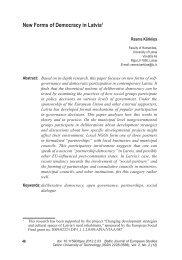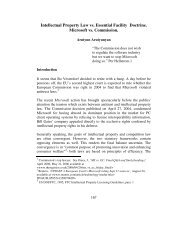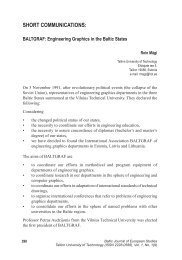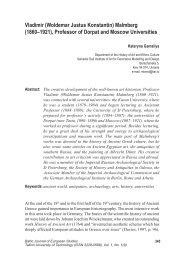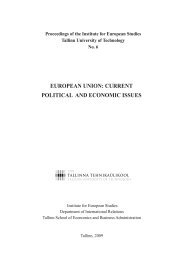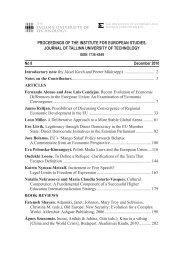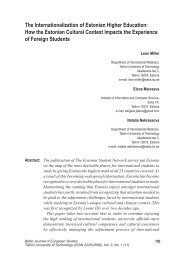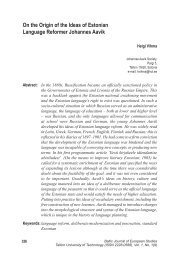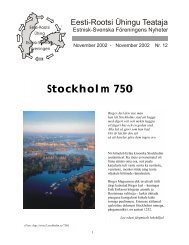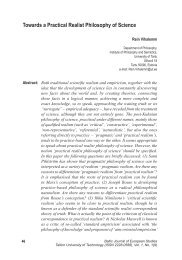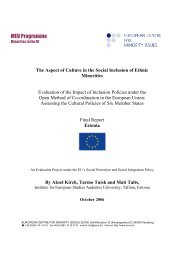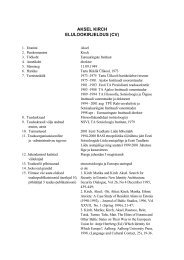Botanical Garden of the university of tartu (dorpat) - The Institute for ...
Botanical Garden of the university of tartu (dorpat) - The Institute for ...
Botanical Garden of the university of tartu (dorpat) - The Institute for ...
You also want an ePaper? Increase the reach of your titles
YUMPU automatically turns print PDFs into web optimized ePapers that Google loves.
<strong>Botanical</strong> <strong>Garden</strong> <strong>of</strong> <strong>the</strong> University <strong>of</strong> Tartu (Dorpat) and<br />
<strong>the</strong> <strong>Botanical</strong> Network in <strong>the</strong> First Half <strong>of</strong> <strong>the</strong> 19 th Century<br />
Introduction<br />
By <strong>the</strong> end <strong>of</strong> <strong>the</strong> 18 th century, a solid botanical network had emerged in Europe,<br />
involving many researchers and amateur naturalists, academic plant taxonomic<br />
research and publishing at universities, numerous extensive expeditions,<br />
botanical gardens, private collections, nurseries and developments in ornamental<br />
gardening. Great numbers <strong>of</strong> plants had been collected in botanical and private<br />
gardens, herbaria had been established, many local and <strong>for</strong>eign floras had been<br />
examined and an extensive botanical bibliography published (Pritzel, 1851, pp.<br />
1–330, 379–391; Meyer, 1857, pp. 254–288; Hill, 1915, pp. 190–223).<br />
<strong>Botanical</strong> science in Russia in <strong>the</strong> 18 th and 19 th century was advanced largely<br />
by natural scientists educated in Germany, France, England, Denmark and<br />
Sweden, who had settled in Russia in <strong>the</strong> 18 th century <strong>for</strong> <strong>the</strong>ir research and <strong>for</strong><br />
arranging research expeditions. At <strong>the</strong> same time, researchers also emerged from<br />
among <strong>the</strong> Baltic Germans. All <strong>the</strong>se researchers published also <strong>the</strong>ir numerous<br />
scientific works in Germany and Russia (Trautvetter, 1837, pp. 4–50, 57–75;<br />
Kolchinsky, 2004, pp. 106–116; Sokol<strong>of</strong>f et al., 2002, pp. 129–191). Thirty-six<br />
better-known botanical gardens with various purposes and names are mentioned<br />
in Russia from <strong>the</strong> 17 th century onward (Trautvetter, 1837, pp. 51–54). Private<br />
gardens were actively established also in <strong>the</strong> provinces <strong>of</strong> Estonia and Livonia,<br />
and also <strong>the</strong> park culture here was highly developed (Hupel, 1791, pp. 534–553;<br />
Germann, 1805, pp. 17–32; Hein, 2007, pp. 15–87).<br />
<strong>The</strong> first private botanical gardens in Russia were established in <strong>the</strong> 18 th century<br />
in <strong>the</strong> manor <strong>of</strong> Demidov near <strong>the</strong> village <strong>of</strong> Krasnoe Solikamsk in <strong>the</strong> Urals<br />
(1731), in <strong>the</strong> Neskuchny Manor <strong>of</strong> Prokopy Demidov in Moscow (1756), and<br />
in <strong>the</strong> manor <strong>of</strong> Alexei Razumovsky at Gorenki (in <strong>the</strong> late 18 th century). In<br />
1771, Ivan Lepekhin registered 422 species in <strong>the</strong> garden <strong>of</strong> Solikamsk, several<br />
<strong>of</strong> <strong>the</strong>m being exotic species. <strong>The</strong> plant catalogue <strong>of</strong> <strong>the</strong> Neskuchny <strong>Garden</strong><br />
contained 2,000 species in 1781 and 4,363 species in 1806. <strong>The</strong> Gorenki <strong>Garden</strong><br />
was led in its early years by botanists Friedrich Christian Stephan (1798–1803),<br />
Ivan Redowsky (1803–1805), and Friedrich Ernst Ludwig von Fischer from<br />
Germany (since 1806), each <strong>of</strong> <strong>the</strong>m giving a contribution to increasing <strong>the</strong><br />
species richness <strong>of</strong> <strong>the</strong> garden. Owing to Fischer, seeds and plants were sent or<br />
brought <strong>the</strong>re by many Russian explorers. In 1803, <strong>the</strong> garden contained 2,846<br />
species, while <strong>the</strong> collection had increased to 8,036 species by 1812 (Trautvetter,<br />
1837, pp. 52–53; Sokol<strong>of</strong>f et al., 2002, pp. 161–169, 182–183; Elina, 2006, pp.<br />
582–583).<br />
Baltic Journal <strong>of</strong> European Studies<br />
Tallinn University <strong>of</strong> Technology (ISSN 2228-0588), Vol. 1, No. 1(9)<br />
231



